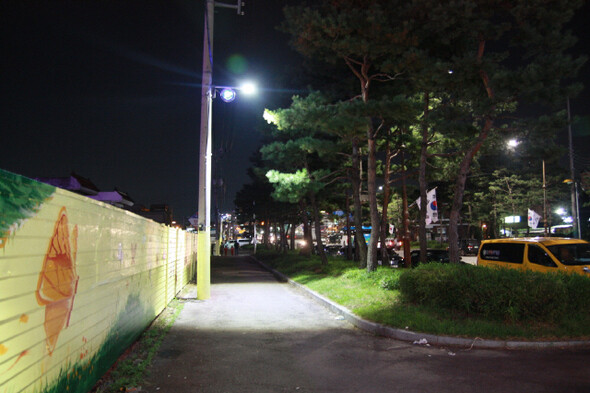hankyoreh
Links to other country sites 다른 나라 사이트 링크
To reduce crime, city puts “broken windows” theory into action

By Song In-geol, Daejeon correspondent
South Chungcheong Province is becoming the first place in South Korea to adopt a Crime Prevention Through Environmental Design (CPTED) program at the provincial level.
The idea, which holds that crime can be prevented through environmental improvements, was first developed in the US in the 1970s by urban planners such as Ray Jeffrey. It was bolstered by the “broken windows theory,” introduced in a 1982 article by US criminologist James Q. Wilson, which holds that signs of neglect and dilapidation (“broken windows”) lead to higher rates of crime in their surrounding areas.
In South Korea, the CPTED system was first introduced in the “new city” of Gwanggyo, Gyeonggi Province in 2008. Since then, programs have successfully been adopted in Busan’s Deokpo neighborhood, Jeju, Daegu, and Seoul’s Gangseo district.
The Cheonan Northwest Police Station in South Chungcheong Province, headed by Hong Wan-seon, announced on Oct. 16 that the road in front of Cheonan Seobu Station in the district’s Seongjeong neighborhood had been selected as a pilot area for women’s safe pedestrian travel, with improvements made to the environment in accordance with CPTED principles.
The area is a kind of red light district with many bars and there have been 170 crimes involving women so far this year - accounting for 58.6% of the 290 crimes in Cheonan and 22% of the 771 in South Chungcheong Province.
The question now is whether environmental improvements can actually reduce crime in such a dangerous area.
Police and city staffers went to work improving the area’s environment back in August: switching out fluorescent streetlights with environmentally friendly LED lights that were more than four times brighter, and enlisting the aid of students from nearby Baekseok University to brighten the streets by decorating walls with pictures of flowers and butterflies on a yellow background. The neighborhood was also decorated with images of “Podori,” the police’s cartoon mascot, and emergency bells for contacting the police were installed in various locations.
Also added were state-of-the-art crime prevention cameras that automatically detect and track moving objects and are capable of taking clear pictures even at night.
One immediate change from the brighter street was the disappearance of the homeless people who previously drank in the roadside parks until late at night. Residents welcomed the change, saying they now felt safer walking at night.
“It’s only about five minutes from the station to my house, but the road in front of Seobu Station was so bad that I refused to walk there alone at night, and I had my Mom drive over and pick me up instead,” said Yun Su-min, a 31-year-old graduate student.
“These days it’s a lot brighter, and you can see the crime prevention cameras there, so I’m not afraid to walk alone before 10 o’clock at night,” she said.
If the program is effective, the province’s police plan to expand it to other high crime areas within their jurisdiction.
Baek Seung-yeop, chief of the South Chungcheong police agency, said that the “safe street” in Seongjeong was “the result of applying an urban environmental engineering theory that makes sense in terms of criminal psychology, using it to develop crime prevention measures, and the community joining forces to protect women and children.”
“We hope to see the same effects in Cheonan that New York City did when it reduced subway crime by 40% with the broken windows theory,” Baek added.
Please direct questions or comments to [english@hani.co.kr]

Editorial・opinion
![[Guest essay] Preventing Korean Peninsula from becoming front line of new cold war [Guest essay] Preventing Korean Peninsula from becoming front line of new cold war](https://flexible.img.hani.co.kr/flexible/normal/500/300/imgdb/original/2024/0507/7217150679227807.jpg) [Guest essay] Preventing Korean Peninsula from becoming front line of new cold war
[Guest essay] Preventing Korean Peninsula from becoming front line of new cold war![[Column] The state is back — but is it in business? [Column] The state is back — but is it in business?](https://flexible.img.hani.co.kr/flexible/normal/500/300/imgdb/original/2024/0506/8217149564092725.jpg) [Column] The state is back — but is it in business?
[Column] The state is back — but is it in business?- [Column] Life on our Trisolaris
- [Editorial] Penalties for airing allegations against Korea’s first lady endanger free press
- [Editorial] Yoon must halt procurement of SM-3 interceptor missiles
- [Guest essay] Maybe Korea’s rapid population decline is an opportunity, not a crisis
- [Column] Can Yoon steer diplomacy with Russia, China back on track?
- [Column] Season 2 of special prosecutor probe may be coming to Korea soon
- [Column] Park Geun-hye déjà vu in Yoon Suk-yeol
- [Editorial] New weight of N. Korea’s nuclear threats makes dialogue all the more urgent
Most viewed articles
- 1Behind-the-times gender change regulations leave trans Koreans in the lurch
- 2Family that exposed military cover-up of loved one’s death reflect on Marine’s death
- 3Yoon’s revival of civil affairs senior secretary criticized as shield against judicial scrutiny
- 4South Korean ambassador attends Putin’s inauguration as US and others boycott
- 5Marines who survived flood that killed colleague urge president to OK special counsel probe
- 6‘Weddingflation’ breaks the bank for Korean couples-to-be
- 7Yoon’s broken-compass diplomacy is steering Korea into serving US, Japanese interests
- 8Hybe-Ador dispute shines light on pervasive issues behind K-pop’s tidy facade
- 9Lee Jung-jae of “Squid Game” named on A100 list of most influential Asian Pacific leaders
- 10[Guest essay] Preventing Korean Peninsula from becoming front line of new cold war